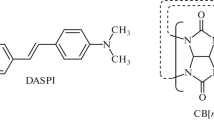Abstract
A new approach to the theoretical evaluation of the local dielectric properties of media that contain an organic dye acting as a nanoprobe is proposed. The method is checked so as to evaluate the dielectric properties of the host molecule in a supramolecular inclusion complex from the experimentally measured shift of the optical absorption spectrum of the guest molecules (dye) after the complex formation. Using the Onsager–Liptay model, the dielectric properties of the cucurbit[7]uril cavity was theoretically estimated by analyzing the experimentally measured shift of the absorption spectrum of 1-(3-ammoniopropyl)-4-[(E)-2-(3,4-dimethoxyphenyl)-ethenyl]-pyridinium dication of the dye after it forms a complex with cucurbit[7]uril in an aqueous solution. To parameterize the Onsager–Liptay equation, the positions of the absorption spectral maxima of the dye under study were experimentally measured in the following solvents with known dielectric and optical properties: methanol, ethanol, 1-propanol, 1-butanol, and water. When calculating molecular structures, dipole moments of the ground and excited states, and polarizability, the TD-DFT quantum chemical method with the CAM-B3LYP functional in the 6-311G(d,p) basis set was used within the Gamess (United States) software package. The obtained theoretical value of the effective dielectric permittivity of the cavity (about 13) is in good agreement with the published value.






Similar content being viewed by others
REFERENCES
D. Magde, R. Wong, and P. G. Seybold, Photochem. Photobiol. 75, 327 (2002).
L. Onsager, J. Am. Chem. Soc. 58, 1486 (1936).
V. G. Plotnikov, V. A. Sazhnikov, and M. V. Alfimov, High Energy Chem. 41, 288 (2007).
S. P. Gromov, A. I. Vedernikov, S. K. Sazonov, N. A. Lobova, and M. V. Alfimov, RF Patent No. 2383571, Byull. Izobret., No. 7 (2010).
V. G. Avakyan, A. S. Stepko, N. A. Lobova, E. Yu. Grushnikova, S. K. Sazonov, S. P. Gromov, V. G. Plotnikov, and P. V. Lebedev-Stepanov, Dokl. Phys. Chem. 476, 169 (2017).
A. I. Vedernikov, L. G. Kuz’mina, S. K. Sazonov, N. A. Lobova, P. S. Loginov, A. V. Churakov, Yu. A. Strelenko, J. A. Howard, M. V. Alfimov, and S. P. Gromov, Russ. Chem. Bull. 56, 1860 (2007).
S. P. Gromov, A. I. Vedernikov, L. G. Kuz’mina, D. V. Kondratuk, S. K. Sazonov, Y. A. Strelenko, M. V. Alfimov, and J. A. K. Howard, Eur. J. Org. Chem., No. 13, 2587 (2010).
N. G. Bakhshiev, Photophysics of Dipole–Dipole Interactions: The Processes of Solvation and Complexation (SPb. Gos. Univ., St. Petersburg, 2006) [in Russian].
C. Reichardt, Chem. Rev. 94, 2319 (1994).
N. G. Bakhshiev, Spectroscopy of Intermolecular Interactions (Nauka, Leningrad, 1972) [in Russian].
P. V. Komarov and V. G. Plotnikov, Int. J. Quant. Chem. 112, 3039 (2012).
K. G. Komarova, S. N. Sakipov, V. G. Plotnikov, and M. V. Alfimov, J. Lumin. 164, 57 (2015).
Modern Quantum Chemistry, Part II: Interactions, Ed. by W. Liptay and O. Sinanoglu (Academic, New York, 1965), Ch. 5, p. 282.
J. Rumble, CRC Handbook of Chemistry and Physics, 98th ed. (CRC, Boca Raton, 2017).
M. W. Schmidt, K. K. Baldridge, J. A. Boatz, S. T. Elbert, M. S. Gordon, J. H. Jensen, S. Koseki, N. Matsunaga, K. A. Nguyen, S. Su, T. L. Windus, M. Dupuis, and J. A. Montgomery, J. Comput. Chem. 14, 1347 (1993).
M. S. Gordon and M. W. Schmidt, in Theory and Applications of Computational Chemistry: The First Forty Years, Ed. by C. E. Dykstra, G. Frenking, K. S. Kim, and G. E. Scuseria (Elsevier, Amsterdam, 2005), Ch. 41, p. 1167.
M. S. Gordon, Gamess (US). www.msg.chem.iastate.edu/index.html.
A. Bondi, J. Phys. Chem. 68, 441 (1964).
K. I. Assaf and W. M. Nau, Chem. Soc. Rev. 44, 394 (2015).
O. V. Venidiktova, T. M. Valova, V. A. Barachevsky, A. O. Ait, P. V. Lebedev-Stepanov, A. Ya. Vul, L. S. Koltsova, A. I. Shienok, and N. L. Zaichenko, Opt. Spectrosc. 122, 729 (2017).
ACKNOWLEDGMENTS
We are grateful to Prof. V.G. Plotnikov for discussion of theoretical models of solvatochromic spectral shift and Drs. V.G. Avakyan and K.G. Komarova for advice in the field of quantum chemical calculations, as well as Prof. S.P. Gromov for providing facilities to accomplish the experimental part of this study.
Funding
This work was supported by the Ministry of Science and Higher Education within the State assignment FSRC «Crystallography and Photonics» RAS in part of quantum chemistry calculation and experimental study of solvatochromic effect. In addition, this work was supported by the “Improving of the competitiveness” program of the National Research Nuclear University MEPhI (Moscow Engineering Physics Institute) in the part concerning the substantiation of the fitting in accordance with the Onsager–Liptay model.
Author information
Authors and Affiliations
Corresponding author
Additional information
Translated by O. Kadkin
Rights and permissions
About this article
Cite this article
Stepko, A.S., Lobova, N.A. & Lebedev-Stepanov, P.V. Studying the Dielectric Properties of the Curcubituril Cavity on the Basis of the Solvatochromic Effect of Styryl Dye upon the Formation of an Inclusion Complex. Opt. Spectrosc. 126, 309–315 (2019). https://doi.org/10.1134/S0030400X19040210
Received:
Revised:
Accepted:
Published:
Issue Date:
DOI: https://doi.org/10.1134/S0030400X19040210




